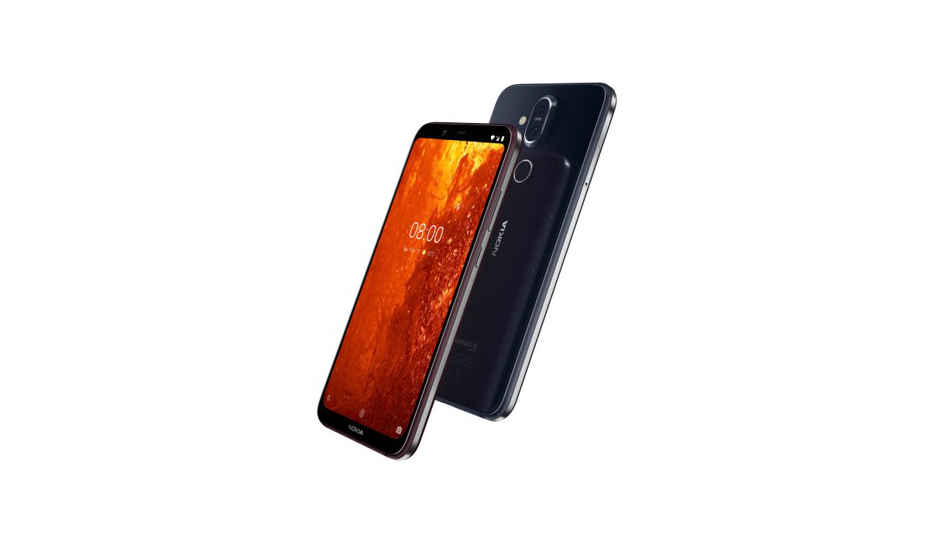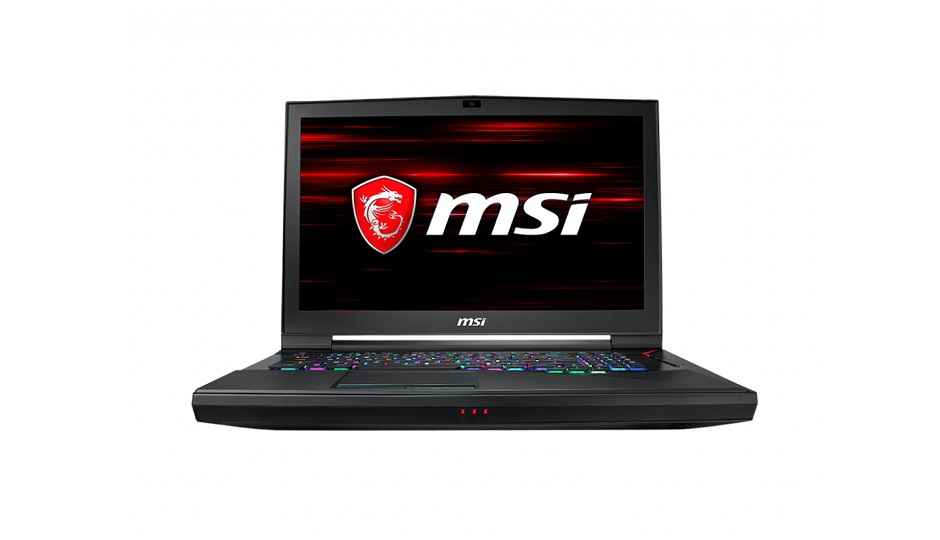 Highlights: Nokia 8.1 will now be available in 6GB RAM, 128GB storage variant. The new model is up for pre-orders and will go on sale from February 6. In December last year, HMD Global launched its Nokia 8.1 smartphone with an HDR 10-supporting PureView display, a dual rear camera setup and more. The smartphone was launched in a 4GB RAM/64GB storage variant that's priced at Rs 26,999. Now, the company has quietly announced a new 6GB RAM/128GB storage variant of the Nokia 8.1 in India. The new variant of the handset with more memory and storage is up for pre-orders priced at Rs 26,999 and will be available via the Nokia Online Store and Amazon.in from February 6. The company has also listed some pre-order offers on the 6GB version of the Nokia 6. Airtel prepaid customers will get to avail 1TB of 4G data on eligible plans starting at Rs 199 and the telcos’ postpaid customers will get an additional 120GB of data, along with three months of free Netflix subscription and one year of Amazon free Prime subscription when they recharge with plans starting at Rs 499. Nokia 8.1 Specifications Like most Nokia smartphones, the Nokia 8.1 is also said to be constructed out of a single block of Series 6000 aluminium with dual-tone diamond cut edges. It is powered by the Qualcomm Snapdragon 710 SoC and now comes in two variants, one with 4GB RAM coupled with 64GB of internal storage and another with 6GB RAM with 128GB of onboard storage. The handset is backed by a 3,500mAh battery and Nokia claims that the phone can last for two days on a single full charge. The phone also supports 18W quick charging. In terms of display, the Nokia 8.1 sports a 6.18-inch full-HD+ display with an 18.7:9 aspect ratio. It comes with HDR 10 support and has a resolution of 1080x2244 pixels. The phone gets a fingerprint sensor on the back as well. The handset is an Android One device that runs on stock Android 9 Pie. In terms of optics, the Nokia 8.1 sports Zeiss optics and comes with Optical Image Stabilization (OIS) and Electronic Image Stabilisation (EIS) support. The phone sports a 12MP primary camera with 1.4-micron pixels, 1/2.55-inch sensor and is paired with a 13MP secondary depth-sensing camera. The phone’s primary camera supports Dual PDAF and can capture 4K videos at 30 frames per second. On the front, the Nokia 8.1 comes with a 20MP sensor, which is said to be optimised for capturing enhanced images in low-light. Related Reads: Nokia 8.1 first-impressions
Highlights: Nokia 8.1 will now be available in 6GB RAM, 128GB storage variant. The new model is up for pre-orders and will go on sale from February 6. In December last year, HMD Global launched its Nokia 8.1 smartphone with an HDR 10-supporting PureView display, a dual rear camera setup and more. The smartphone was launched in a 4GB RAM/64GB storage variant that's priced at Rs 26,999. Now, the company has quietly announced a new 6GB RAM/128GB storage variant of the Nokia 8.1 in India. The new variant of the handset with more memory and storage is up for pre-orders priced at Rs 26,999 and will be available via the Nokia Online Store and Amazon.in from February 6. The company has also listed some pre-order offers on the 6GB version of the Nokia 6. Airtel prepaid customers will get to avail 1TB of 4G data on eligible plans starting at Rs 199 and the telcos’ postpaid customers will get an additional 120GB of data, along with three months of free Netflix subscription and one year of Amazon free Prime subscription when they recharge with plans starting at Rs 499. Nokia 8.1 Specifications Like most Nokia smartphones, the Nokia 8.1 is also said to be constructed out of a single block of Series 6000 aluminium with dual-tone diamond cut edges. It is powered by the Qualcomm Snapdragon 710 SoC and now comes in two variants, one with 4GB RAM coupled with 64GB of internal storage and another with 6GB RAM with 128GB of onboard storage. The handset is backed by a 3,500mAh battery and Nokia claims that the phone can last for two days on a single full charge. The phone also supports 18W quick charging. In terms of display, the Nokia 8.1 sports a 6.18-inch full-HD+ display with an 18.7:9 aspect ratio. It comes with HDR 10 support and has a resolution of 1080x2244 pixels. The phone gets a fingerprint sensor on the back as well. The handset is an Android One device that runs on stock Android 9 Pie. In terms of optics, the Nokia 8.1 sports Zeiss optics and comes with Optical Image Stabilization (OIS) and Electronic Image Stabilisation (EIS) support. The phone sports a 12MP primary camera with 1.4-micron pixels, 1/2.55-inch sensor and is paired with a 13MP secondary depth-sensing camera. The phone’s primary camera supports Dual PDAF and can capture 4K videos at 30 frames per second. On the front, the Nokia 8.1 comes with a 20MP sensor, which is said to be optimised for capturing enhanced images in low-light. Related Reads: Nokia 8.1 first-impressions from Latest Technology News http://bit.ly/2CWcpP8
 Highlights: Redmi Note 7 is reportedly launching on February 12 The Redmi Note 7 has already been launched in China Both Xiaomi and Redmi have been teasing the Note 7 phone with a 48MP camera setup on their Indian social media accounts. Last week, the teasers promised market disruption, though the exact launch date of the phones was not known. Citing industry sources, 91mobiles has now claimed that it has procured a launch event invite which allegedly says that Redmi will launch the Note 7 in India on February 12. Comments on the teaser tweeted by Xiaomi and Redmi suggested that the Redmi Note 7 could launch in India on February 14. This was because Xiaomi launched the Redmi Note 5 Pro in India on the same date last year. The Redmi Note 7 starts at 999 Yuan in China (approx. Rs 10,000) for the 3GB+32GB variant. The 4GB+64GB variant is priced 1199 Yuan (approx Rs 12,500) and the 6GB+64GB variant retails for 1399 Yuan, which is approximately Rs 14,500. Redmi Note 7 specifications: The Redmi Note 7 sports a waterdrop notch on top of a 6.3-inch LCD panel offering a resolution 2340x1080 pixels. The phone has a 2.5D curved glass chassis and has a rear-mounted fingerprint sensor. Under the hood is a Qualcomm Snapdragon 660 SoC. In China, the phone is offered in 3GB, 4GB or 6GB RAM variants, while the storage variants are 32GB or 64GB. There is a 4,000mAh battery inside, which is same as the one in the phone’s predecessor. The rear camera unit is aligned vertically in the top corner with a single LED flash unit below the camera. This is the first Redmi phone with a 48MP sensor combined with a 5MP secondary sensor for portrait shots. Redmi claims the 48MP sensor helps take better shots in low-light as well as poster-like HD photos. On the front is a 13MP camera featuring AI algorithms for face beautification and portrait mode. The smartphone will run MIUI 10 out of the box. Related Report: Xiaomi CEO confirms Redmi will be a separate brand
Highlights: Redmi Note 7 is reportedly launching on February 12 The Redmi Note 7 has already been launched in China Both Xiaomi and Redmi have been teasing the Note 7 phone with a 48MP camera setup on their Indian social media accounts. Last week, the teasers promised market disruption, though the exact launch date of the phones was not known. Citing industry sources, 91mobiles has now claimed that it has procured a launch event invite which allegedly says that Redmi will launch the Note 7 in India on February 12. Comments on the teaser tweeted by Xiaomi and Redmi suggested that the Redmi Note 7 could launch in India on February 14. This was because Xiaomi launched the Redmi Note 5 Pro in India on the same date last year. The Redmi Note 7 starts at 999 Yuan in China (approx. Rs 10,000) for the 3GB+32GB variant. The 4GB+64GB variant is priced 1199 Yuan (approx Rs 12,500) and the 6GB+64GB variant retails for 1399 Yuan, which is approximately Rs 14,500. Redmi Note 7 specifications: The Redmi Note 7 sports a waterdrop notch on top of a 6.3-inch LCD panel offering a resolution 2340x1080 pixels. The phone has a 2.5D curved glass chassis and has a rear-mounted fingerprint sensor. Under the hood is a Qualcomm Snapdragon 660 SoC. In China, the phone is offered in 3GB, 4GB or 6GB RAM variants, while the storage variants are 32GB or 64GB. There is a 4,000mAh battery inside, which is same as the one in the phone’s predecessor. The rear camera unit is aligned vertically in the top corner with a single LED flash unit below the camera. This is the first Redmi phone with a 48MP sensor combined with a 5MP secondary sensor for portrait shots. Redmi claims the 48MP sensor helps take better shots in low-light as well as poster-like HD photos. On the front is a 13MP camera featuring AI algorithms for face beautification and portrait mode. The smartphone will run MIUI 10 out of the box. Related Report: Xiaomi CEO confirms Redmi will be a separate brand We are just a few days away from the launch of Samsung’s flagship devices for 2019, the Samsung Galaxy S10 and Galaxy S10+. Therefore, leaks of the two phones are in full swing and with just a few days left for the final reveal, it turns out, alleged press renders of the device have leaked, revealing the design in full. The design reveals that Samsung has managed to really narrow down the top and bottom chins by moving the front facing camera into the display. Additionally, it appears that the company is getting rid of its Iris scanner technology so as to reduce the clutter on top. In its place, the Galaxy S10 and Galaxy S10+ will utilise an in-display fingerprint sensor. This is further corroborated by the fact that there is no fingerprint scanner on the back, as shown by the press renders. Looking at the back, we also see a triple camera setup on the back. Interestingly, the renders show three colours for each variant; a black and two new finishes of green and the already seen Polaris Blue. The other interesting revelation from the press renders is the corners of the devices, which appear to have a sharper edge in comparison to the S9 and S9+. Samsung Galaxy S10+ in Polaris Blue Samsung Galaxy S10 in Green The Samsung Galaxy S10 and Galaxy S10+ will sport Qualcomm’s newest Snapdragon 855 in some markets and the company’s own Exynos 9820 processor in other markets. Rumours suggest that there may be a variant of the S10+ which will sport a whopping 1TB of storage. This is substantiated somewhat by the fact that Samsung just announced the production of its 1TB UFS 3.0 storage chip. Samsung is expected to announce the Samsung Galaxy S10 and Samsung Galaxy S10+ on the 20th of February, just ahead of Mobile World Congress 2019. We know that the S10 has already entered mass production. The 5G variant of the phone is expected to go into production a little later. The company is expected to showcase both the 5G variant of the S10 series and the foldable smartphone during its Unpacked event.
We are just a few days away from the launch of Samsung’s flagship devices for 2019, the Samsung Galaxy S10 and Galaxy S10+. Therefore, leaks of the two phones are in full swing and with just a few days left for the final reveal, it turns out, alleged press renders of the device have leaked, revealing the design in full. The design reveals that Samsung has managed to really narrow down the top and bottom chins by moving the front facing camera into the display. Additionally, it appears that the company is getting rid of its Iris scanner technology so as to reduce the clutter on top. In its place, the Galaxy S10 and Galaxy S10+ will utilise an in-display fingerprint sensor. This is further corroborated by the fact that there is no fingerprint scanner on the back, as shown by the press renders. Looking at the back, we also see a triple camera setup on the back. Interestingly, the renders show three colours for each variant; a black and two new finishes of green and the already seen Polaris Blue. The other interesting revelation from the press renders is the corners of the devices, which appear to have a sharper edge in comparison to the S9 and S9+. Samsung Galaxy S10+ in Polaris Blue Samsung Galaxy S10 in Green The Samsung Galaxy S10 and Galaxy S10+ will sport Qualcomm’s newest Snapdragon 855 in some markets and the company’s own Exynos 9820 processor in other markets. Rumours suggest that there may be a variant of the S10+ which will sport a whopping 1TB of storage. This is substantiated somewhat by the fact that Samsung just announced the production of its 1TB UFS 3.0 storage chip. Samsung is expected to announce the Samsung Galaxy S10 and Samsung Galaxy S10+ on the 20th of February, just ahead of Mobile World Congress 2019. We know that the S10 has already entered mass production. The 5G variant of the phone is expected to go into production a little later. The company is expected to showcase both the 5G variant of the S10 series and the foldable smartphone during its Unpacked event. Highlights: MSI has launched its updated G-series and P-series of laptops in India The G-series laptos get NVIDIA GeForce RTX graphics The P-series laptops stand for 'Prestige' The new models are currently available in India MSI has launched new gaming laptops in India under its G-series line-up. It has also unveiled new laptops under its P-series for creators. The new models are currently available on Flipkart and at MSI exclusive stores in major cities across India like New Delhi, Bengaluru, Pune, and Kolkata. The price of the new G-series gaming laptops starts at Rs 79,990 and goes all the way up to Rs 3,99,990 while the price of the P-series laptops starts at Rs 77,990. According to a recent report by Gadgets 360, the new laptops launched under the G-series include the GT75 Titan, GS65 Stealth Thin, GE75 Raider, and GL73. The GT, GS, GE, and GL models in MSI’s new line-up will come with NVIDIA GeForce RTX graphics. New models under the Taiwanese company’s P-series, where P stands for Prestige, include the P65 Creator, PS42, and PS63. MSI had officially announced these models at this year’s CES in Las Vegas. The highest variant of the MSI GT75 Titan comes with an 8th Gen Intel Core i9 CPU, up to 32GB of RAM, and up to 1TB of PCIe SSD storage. The display has a maximum resolution of 3840 x 2160 pixels. Rendering graphics on it is an NVIDIA GeForce RTX 2080 GPU with 8GB of GDDR6 vRAM. Its price is a staggering Rs 3,99,990. The highest variant of the MSI GE75 Raider, on the other hand, comes with an 8th Gen Intel Core i7 CPU, NVIDIA GeForce RTX 2080 GPU, 16GB of RAM, and up to 512GB of SSD-based storage. Its price starts at Rs 1,94,990. The highest variant of the MSI GS65 Stealth Thin, costing Rs 2,09,990, gets an 8th Gen Intel Core i7 CPU, NVIDIA GeForce GTX 2070 GPU, 16GB of RAM, and 512GB of SSD storage. The GL73 comes with a similar configuration but gets an NVIDIA GeForce RTX 2060 GPU, 16GB of RAM, and 256GB of SSD storage for Rs 1,58,990. Under the company’s new P-series laptops, the P65 Creator is the most sophisticated. It comes with an 8th Gen Intel Core i7 CPU, NVIDIA GeForce GTX 1050 Ti GPU, up to 32GB of RAM, and 512GB of SSD-based storage for Rs 1,59,990. The PS63 and PS42 come with a 15.6-inch and 14-inch display respectively. The highest variant in both models comes with an 8th Gen Intel Core i7 CPU, NVIDIA GeForce GTX 1050 with Max-Q (or GeForce MX250) GPU, 16GB of RAM, and 512GB of SSD storage. The PS63 starts at Rs 99,990 while the PS42 starts at Rs 77,990. Related Read: Asus F570 Review
Highlights: MSI has launched its updated G-series and P-series of laptops in India The G-series laptos get NVIDIA GeForce RTX graphics The P-series laptops stand for 'Prestige' The new models are currently available in India MSI has launched new gaming laptops in India under its G-series line-up. It has also unveiled new laptops under its P-series for creators. The new models are currently available on Flipkart and at MSI exclusive stores in major cities across India like New Delhi, Bengaluru, Pune, and Kolkata. The price of the new G-series gaming laptops starts at Rs 79,990 and goes all the way up to Rs 3,99,990 while the price of the P-series laptops starts at Rs 77,990. According to a recent report by Gadgets 360, the new laptops launched under the G-series include the GT75 Titan, GS65 Stealth Thin, GE75 Raider, and GL73. The GT, GS, GE, and GL models in MSI’s new line-up will come with NVIDIA GeForce RTX graphics. New models under the Taiwanese company’s P-series, where P stands for Prestige, include the P65 Creator, PS42, and PS63. MSI had officially announced these models at this year’s CES in Las Vegas. The highest variant of the MSI GT75 Titan comes with an 8th Gen Intel Core i9 CPU, up to 32GB of RAM, and up to 1TB of PCIe SSD storage. The display has a maximum resolution of 3840 x 2160 pixels. Rendering graphics on it is an NVIDIA GeForce RTX 2080 GPU with 8GB of GDDR6 vRAM. Its price is a staggering Rs 3,99,990. The highest variant of the MSI GE75 Raider, on the other hand, comes with an 8th Gen Intel Core i7 CPU, NVIDIA GeForce RTX 2080 GPU, 16GB of RAM, and up to 512GB of SSD-based storage. Its price starts at Rs 1,94,990. The highest variant of the MSI GS65 Stealth Thin, costing Rs 2,09,990, gets an 8th Gen Intel Core i7 CPU, NVIDIA GeForce GTX 2070 GPU, 16GB of RAM, and 512GB of SSD storage. The GL73 comes with a similar configuration but gets an NVIDIA GeForce RTX 2060 GPU, 16GB of RAM, and 256GB of SSD storage for Rs 1,58,990. Under the company’s new P-series laptops, the P65 Creator is the most sophisticated. It comes with an 8th Gen Intel Core i7 CPU, NVIDIA GeForce GTX 1050 Ti GPU, up to 32GB of RAM, and 512GB of SSD-based storage for Rs 1,59,990. The PS63 and PS42 come with a 15.6-inch and 14-inch display respectively. The highest variant in both models comes with an 8th Gen Intel Core i7 CPU, NVIDIA GeForce GTX 1050 with Max-Q (or GeForce MX250) GPU, 16GB of RAM, and 512GB of SSD storage. The PS63 starts at Rs 99,990 while the PS42 starts at Rs 77,990. Related Read: Asus F570 Review The Oppo K1 is going to launch in India on Feb 5th. The phone was released in China back in October last year with an in-display fingerprint sensor and a Qualcomm Snapdragon 660 under the hood. The phone has a 25MP selfie camera and is expected to come around Rs 20,000. On the other hand, we have the Xiaomi Poco F1, which is powered by a Qualcomm Snapdragon 845 processor and has a dual camera setup on the back. Let’s begin with a quick specs comparison to know which device is more powerful when it comes to hardware at least on paper. The Oppo K1 features a 6.4-inch display that offers a resolution of 1080 x 2340 pixels, while the Xiaomi Poco F1 sports a slightly smaller 6.18-inch display that comes with a resolution of 1080 x 2246 pixels. When it comes to the processor, the Oppo K1 is powered by a Qualcomm Snapdragon 660 processor, which is coupled with 4GB RAM and 64GB internal memory. The phone is expected to launch in India in 6GB variant as well. On the other hand, the Xiaomi Poco F1 is equipped with a faster Qualcomm Snapdragon 845 processor, which is paired with 6GB RAM and 128GB internal memory. The Poco F1 will also available in the 8GB/256GB storage model. As far as the cameras are concerned, one of the main highlights of Oppo K1 is its 25MP selfie camera and a dual 13MP + 2MP camera setup on the back. The Xiaomi Poco F1 also has a dual 12MP + 5MP rear cameras along with a 20MP sensor on the front. The Oppo K1 will launch in India on February 5, while the Xiaomi Poco F1 is available in India for Rs 19,999.
The Oppo K1 is going to launch in India on Feb 5th. The phone was released in China back in October last year with an in-display fingerprint sensor and a Qualcomm Snapdragon 660 under the hood. The phone has a 25MP selfie camera and is expected to come around Rs 20,000. On the other hand, we have the Xiaomi Poco F1, which is powered by a Qualcomm Snapdragon 845 processor and has a dual camera setup on the back. Let’s begin with a quick specs comparison to know which device is more powerful when it comes to hardware at least on paper. The Oppo K1 features a 6.4-inch display that offers a resolution of 1080 x 2340 pixels, while the Xiaomi Poco F1 sports a slightly smaller 6.18-inch display that comes with a resolution of 1080 x 2246 pixels. When it comes to the processor, the Oppo K1 is powered by a Qualcomm Snapdragon 660 processor, which is coupled with 4GB RAM and 64GB internal memory. The phone is expected to launch in India in 6GB variant as well. On the other hand, the Xiaomi Poco F1 is equipped with a faster Qualcomm Snapdragon 845 processor, which is paired with 6GB RAM and 128GB internal memory. The Poco F1 will also available in the 8GB/256GB storage model. As far as the cameras are concerned, one of the main highlights of Oppo K1 is its 25MP selfie camera and a dual 13MP + 2MP camera setup on the back. The Xiaomi Poco F1 also has a dual 12MP + 5MP rear cameras along with a 20MP sensor on the front. The Oppo K1 will launch in India on February 5, while the Xiaomi Poco F1 is available in India for Rs 19,999. Highlights: Apple briefly stops Google from running its internal iOS apps Both Facebook and Google are now allowed to use them Google was also allegedly spying on people Just when the media was criticising Facebook for spying on teenagers through an app, Apple dropped a bomb on Google by measuring the search engine giant with the same yardstick that it used with the social media platform - in simpler words - revoking Google’s Enterprise Certificate that allowed it to distribute its own private app and allegedly monitored iPhone usage. The move can be seen as Apple’s reaffirmation of itself as an advocate of users’ privacy, and a powerful tech entity that does not kneel down to the (implied) data-hungry competitors. Though Apple has let Facebook use internal iOS apps and restored functionality to Google’s apps, it should be clear that the Cupertino-based giant is clearly sticking to its rules and applying them equally to any company that may get caught breaking its rules in the future. Just like Facebook, Google’s Screenwise Meter came under the lens for tracking users and rewarding them with gift cards for letting Google collect information on their internet usage. Google has released a statement clarifying its stance. “The Screenwise Meter iOS app should not have operated under Apple’s developer enterprise program — this was a mistake, and we apologize. We have disabled this app on iOS devices. This app is completely voluntary and always has been. We’ve been upfront with users about the way we use their data in this app, we have no access to encrypted data in apps and on devices, and users can opt out of the program at any time,” Google spokesperson told The Verge. A person familiar with the situation told The Verge that the “early versions of Google Maps, Hangouts, Gmail, and other pre-release beta apps stopped working alongside employee-only apps like a Gbus app for transportation and Google’s internal cafe app.” Reportedly, Amazon, DoorDash, and Sonos all distribute beta versions of their apps to non-employees and could face the same action as the Google and Facebook. Related Read: Apple bans Facebook Research App that allegedly spied on teenagers
Highlights: Apple briefly stops Google from running its internal iOS apps Both Facebook and Google are now allowed to use them Google was also allegedly spying on people Just when the media was criticising Facebook for spying on teenagers through an app, Apple dropped a bomb on Google by measuring the search engine giant with the same yardstick that it used with the social media platform - in simpler words - revoking Google’s Enterprise Certificate that allowed it to distribute its own private app and allegedly monitored iPhone usage. The move can be seen as Apple’s reaffirmation of itself as an advocate of users’ privacy, and a powerful tech entity that does not kneel down to the (implied) data-hungry competitors. Though Apple has let Facebook use internal iOS apps and restored functionality to Google’s apps, it should be clear that the Cupertino-based giant is clearly sticking to its rules and applying them equally to any company that may get caught breaking its rules in the future. Just like Facebook, Google’s Screenwise Meter came under the lens for tracking users and rewarding them with gift cards for letting Google collect information on their internet usage. Google has released a statement clarifying its stance. “The Screenwise Meter iOS app should not have operated under Apple’s developer enterprise program — this was a mistake, and we apologize. We have disabled this app on iOS devices. This app is completely voluntary and always has been. We’ve been upfront with users about the way we use their data in this app, we have no access to encrypted data in apps and on devices, and users can opt out of the program at any time,” Google spokesperson told The Verge. A person familiar with the situation told The Verge that the “early versions of Google Maps, Hangouts, Gmail, and other pre-release beta apps stopped working alongside employee-only apps like a Gbus app for transportation and Google’s internal cafe app.” Reportedly, Amazon, DoorDash, and Sonos all distribute beta versions of their apps to non-employees and could face the same action as the Google and Facebook. Related Read: Apple bans Facebook Research App that allegedly spied on teenagers